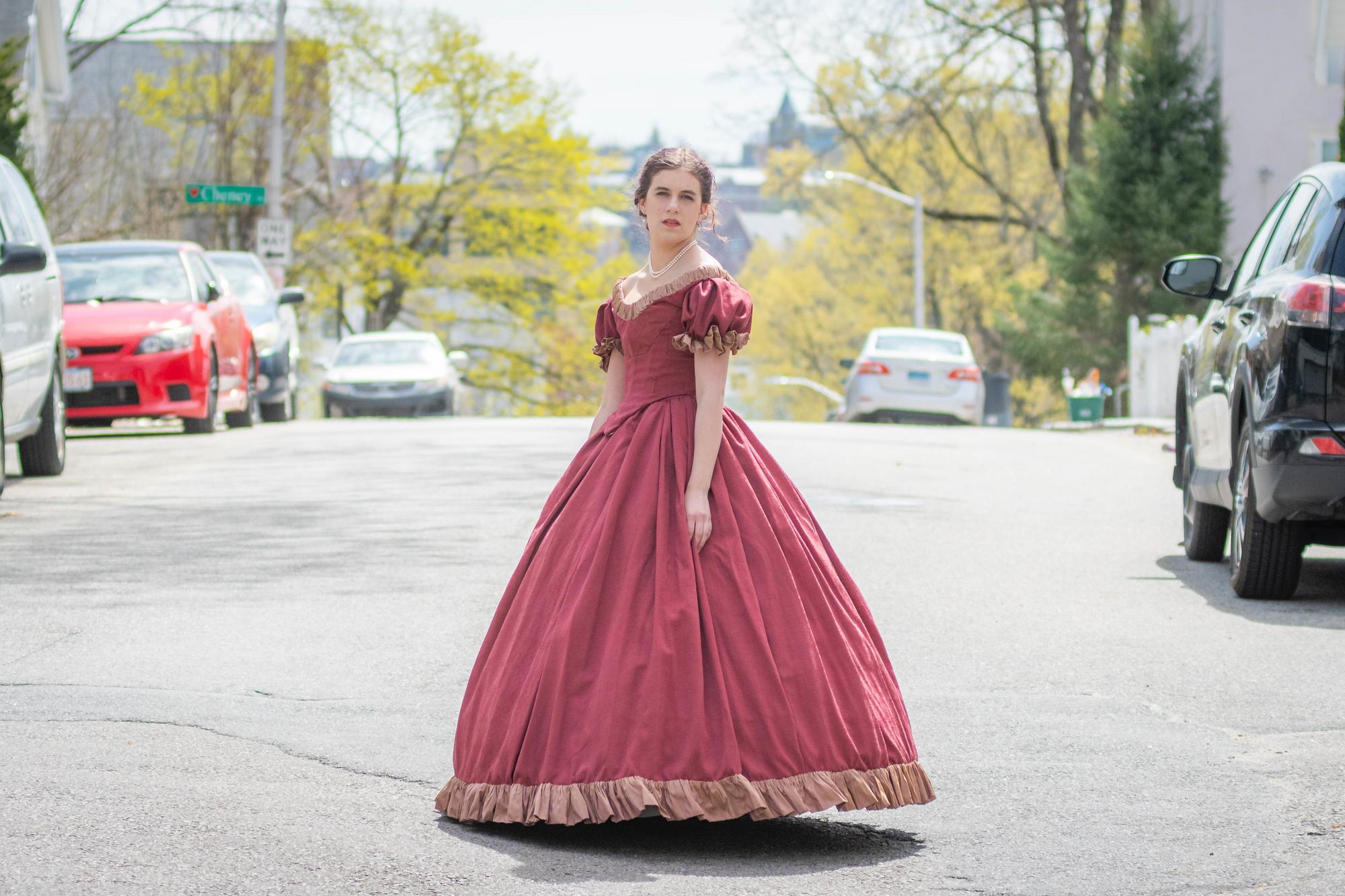A stitch in time: Hannah Olech ’20 brings the past to life through historical dressmaking

Sitting at a small table in her Worcester apartment, Hannah Olech ’20 carefully stitches straps to a silk, Elizabethan-era garment. The piece, which resembles a corset and would have been known as a “pair of bodies” in the 16th century, is part of 11 historical outfits Olech has sewn over the past five years, covering time periods that span from the Middle Ages to the early 1900s.
“It’s a way I destress and a creative outlet for me,” says Olech, who graduated with her bachelor’s degree in biology in December. “When I was at Clark, that was a good way to compartmentalize. I had my STEM-based school work and I’ve always loved science, but when I’m not working, I want to be doing something fun, but also something calm and quiet.”
In addition to providing a way to unwind, costume designing has allowed Olech to combine her passion for history with her experience as a seamstress. Growing up, Olech’s parents and stepparents brought her to living history museums and Renaissance fairs, sparking her interest in the past at a young age. Today, she draws much of her inspiration from unique materials she acquires and from dresses she sees online or on television. While watching “Pride & Prejudice,” for example, she decided she wanted a Regency dress and began planning.
“I’ve always been a little over the top in that I’ve enjoyed dressing up. I had trunks full of dress-up clothes as a kid, and when I got older I wanted historical clothes but looked at their price tag and was astonished,” she says. “I wondered, ‘How difficult is it to make them?’ I started very simple and it went from there.”
(Story continues after video)
Olech begins the dressmaking process by visualizing and then sketching out a design from a particular era. She then conducts online research to confirm that a similar outfit to the one she’s envisioned was worn in that time period and for the occasion she has in mind. She may discover a garment preserved in a museum, or images of a dress in a painting or vintage fashion magazine.
“If I find something like that existed, I will color the sketch in, finalize it, and move forward. If not, I will tweak it to something close to my idea,” she says.
With a design in hand, Olech determines what foundations and accessories should accompany the outfit and what materials to source — considering each fabric’s color, weight, and fiber. Finally, she sews, using a combination of hand stitching, embroidery, and machine sewing — and sometimes painting and beading — to craft each piece. Completion time varies depending on the project’s complexity, including whether Olech is drafting her own design or using an existing pattern. The process can take anywhere from a week to months.
Of the 11 historical pieces she’s created, Olech is proudest of her early 1890s walking suit, which would have been worn by wealthy women who spent their days walking, shopping, or visiting relatives. The navy-blue outfit includes a tailored wool jacket with hand-embroidered flowers, matching hat, and silk blouse adorned with antique lace from the turn of the last century that Olech received as a gift from her mother.
“I’m a big proponent of not destroying historic garments, but if you have a scrap that’s already been cut away, you should use it,” she says. “I don’t believe in taking a little scrap of lace and tucking it away in a box. It’s meant to be seen and worn on a piece of clothing. That’s a good way to give it life.”
Her favorite piece to wear is a red 1850s Christmas evening gown with a large skirt supported by a crinoline cage and an off-the-shoulder neckline. “I feel like a princess,” she says. “I love wearing it.”
When Olech shares images of her outfits on social media, commenters urge her to become a costume designer or work for a theater company — but that’s not in her plans. Olech, who has always been fascinated by forensic science, anatomy, and medicine, hopes to earn her master’s degree in microbiology or immunology with the ultimate goal of going to medical school.
“If costuming becomes work, if there are deadlines and expectations and people who might be unhappy, then it’s not as fun anymore,” she says. “I separate what I want to do for my job from what I want to do that makes me smile.”
Olech gets asked what she plans to do with all the pieces she’s created. For her, it’s just as much about the process as the finished product.
“You don’t really ask a painter what they’re going to do with all of their paintings,” she says. “They just paint because they like to paint, and this is what I do.”


